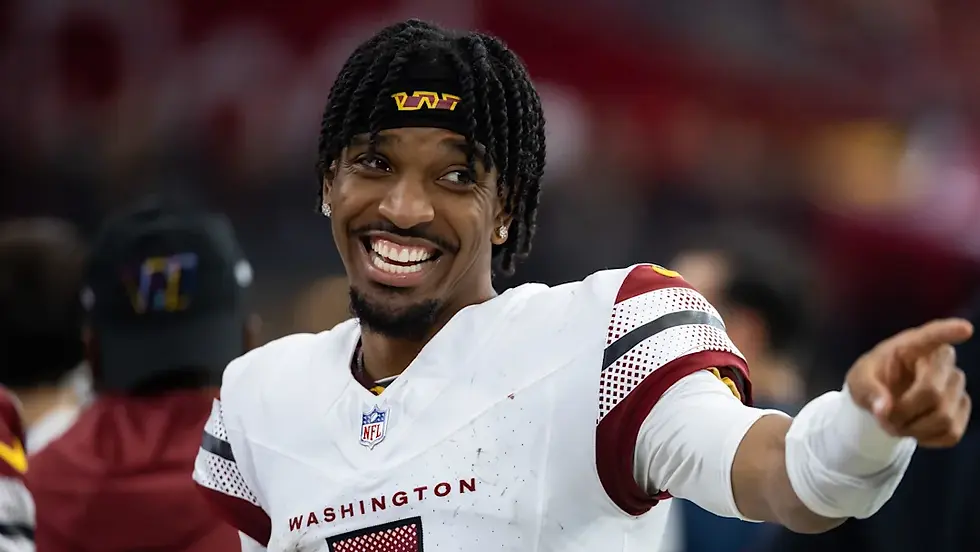Football 101
- Jamie Pridmore
- Sep 11, 2024
- 3 min read
American Football is simply two teams kicking, throwing, and running a football from one side to the other without getting tackled or letting the ball touch the ground. Of course there are rules that must be followed so the game is fair to everyone involved and there are specific positions the players have within the game. I have broken down part of the game of football to help you understand it a little bit more. Below you can get a better sense of how many players can be on the field during the play, each position on offense and defense, and some additional information that helps with understanding the game (i.e. line of scrimmage, what you may see while watching the game on television, etc.).
Number of players on the field per team: 11
Positions:
Offense:
(QB) Quarterback (Offensive leader; passes or hands off the ball to backs)
(FB) Fullback (runs with ball), Also referred to as (RB) Running Back
(HB) Halfback (runs with ball), Also referred to as (RB) Running Back
(WR) Wide Receiver (catches forward passes from QB)
(C) Center (hikes or hands the ball to the QB at start of each play, blocks for QB/backs)
(LG/RG) Offensive Guard (blocks for QB / protects QB from defenders), There are two, one on either side of Center
(LT/RT) Offensive Tackle (blocks for QB/backs), There are two with one to each side of a Guard
(TE) Tight End (blocks defenses, catches passes)
Defense:
(SS) Strong Safety (last line of defense, tackle/stop backs, defend against run and short passes)
(FS) Free Safety (deep pass coverage; act as last line of defense, read the QB)
(CB) Cornerback (cover wide receivers, force fumbles with pressure and hard tackles)
(LB) Middle Linebacker (direct the defense, stop inside runs from backs, cover short passes)
(LB) Outside Linebacker (force backs down the center of the field; attack/rush the QB)
(DE) Defensive End (rush/tackle the Quarterback; stop the backs)
(DT) Defensive Tackle (defend running attacks down the middle, fight off blocks)
(NT) Nose Tackle (prevent running plays down the middle)
Special Teams:
Kicker (kicks field goals, extra points and kickoffs)
Long Snapper (snaps/passes the ball for field goals, extra points and punts)
Kick Returner (catch and return kick offs), Punter (punt/kick the ball to the opposing team)
Punt Returner (catch and return punts)
Gunner (cover punts and kickoffs, tackle the returner)
Personal Protector (protect the punter and serve as a last line of defense for punt plays)
Holder (catches the snap/pass from the Long Snapper and holds the ball for the kicker)

Other things to know:
Line of scrimmage: Imaginary line that separates the offense and defense. Players cannot cross the line until the play starts (i.e. the ball is hiked). If a player crosses the line before the ball is hiked then the play will result in a penalty (loss of yards for one of the teams)
Downs: Represent short 10 yard plays where each team tries to move the ball down the field to get a touchdown or field goal. The offense has 4 downs before they are forced a turnover or give the ball to the defense. On the first down the offense has to cover 10 yards with the ball to obtain another first down. However, penalties, dropped catches, and tackles by the defense can prevent this. On the 4th down the offense has to decide where to kick the ball to the other team, pushing them further from the goal when they get the ball, or “go for it” which means going for a first down and hoping they don’t get stopped. If they get stopped before the first down spot then the are forced to turn the ball over to the other team.
Television viewing: Football games are usually streamed live through various networks and along with viewing you are able to listen to the commentary from the announcers of the game. In addition, the network will draw lines on the field to help provide point of reference during the games. For example, there will be a red line on the field that is referencing the line of scrimmage and then yellow lines marking where the team needs to get to in order to get a first down.







Comments